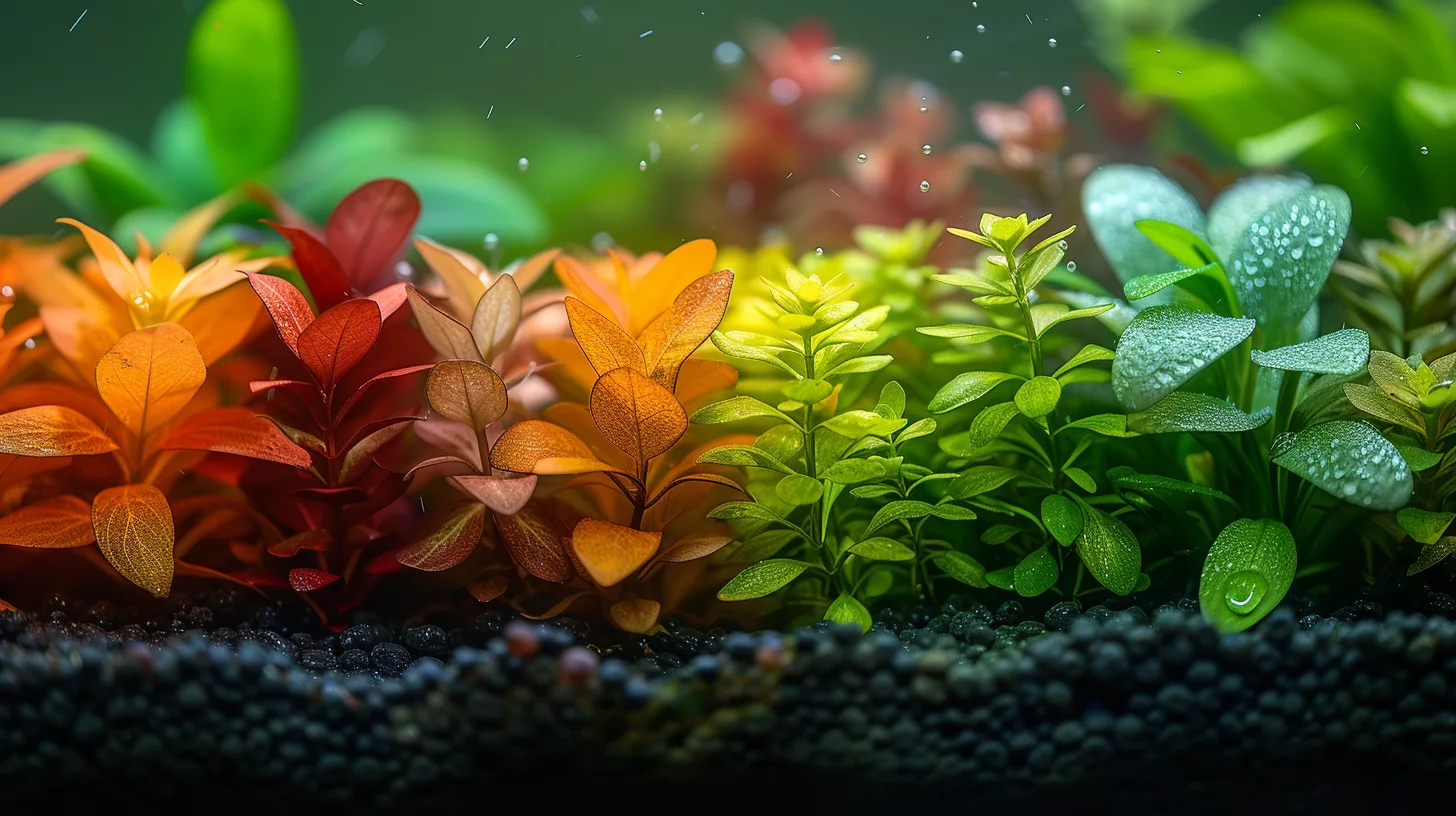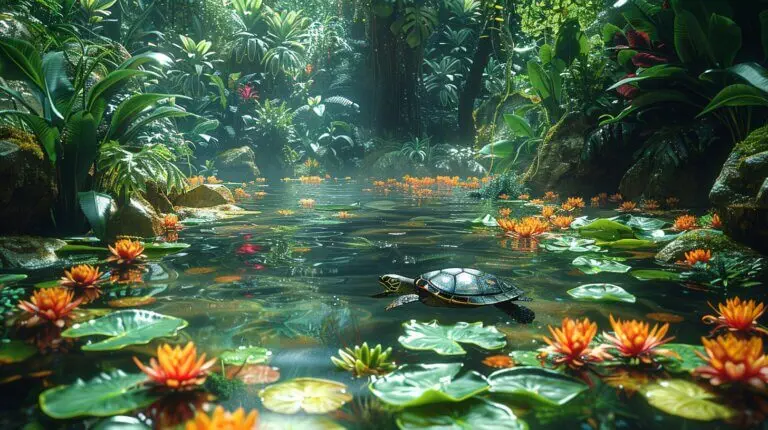While many of us revel in the vibrant fish that dart through our aquariums, it’s the often overlooked freshwater plants that truly transform a tank from a mere display to an underwater sanctuary.
We’ve curated a comprehensive Freshwater Aquarium Plants List With Pictures guide complete with vivid pictures to navigate the lush, yet sometimes perplexing, world of aquatic flora. From the vital role these plants play in your setup to tips for cultivating a thriving aquatic garden, our explorer’s guide is your beacon. If you’re looking to add some greenery to your aquarium, consider incorporating some of the popular and easy-to-care-for freshwater plants featured in our guide. One standout option is growing pothos in water, which can help improve the water quality in your tank while also adding a touch of natural beauty. With our expert advice and stunning visuals, you’ll be well on your way to creating a vibrant underwater oasis that both you and your aquatic pets can enjoy.
Let’s embark on this journey together, where each leaf and stem of versatile plants unfolds a story, and discover how to elevate your aquarium beyond the ordinary.
Key Takeaways
- Freshwater aquarium plants like Anubias and Java Fern, also bright green ones such as vallisneria and hornwort, enhance the beauty and ecosystem of the tank.
- Plants, including stem plants like hornwort and carpeting plants such as vallisneria, are categorized into foreground, midground, and background types for dynamic aquascaping in the home aquarium.
- Many plants, like moss varieties including Java and Christmas Moss, provide natural filtration and shelter.
- Successful plant cultivation requires knowledge of light, nutrients, and proper planting techniques.
Understand the Role of Freshwater Aquarium Plants in Your Setup
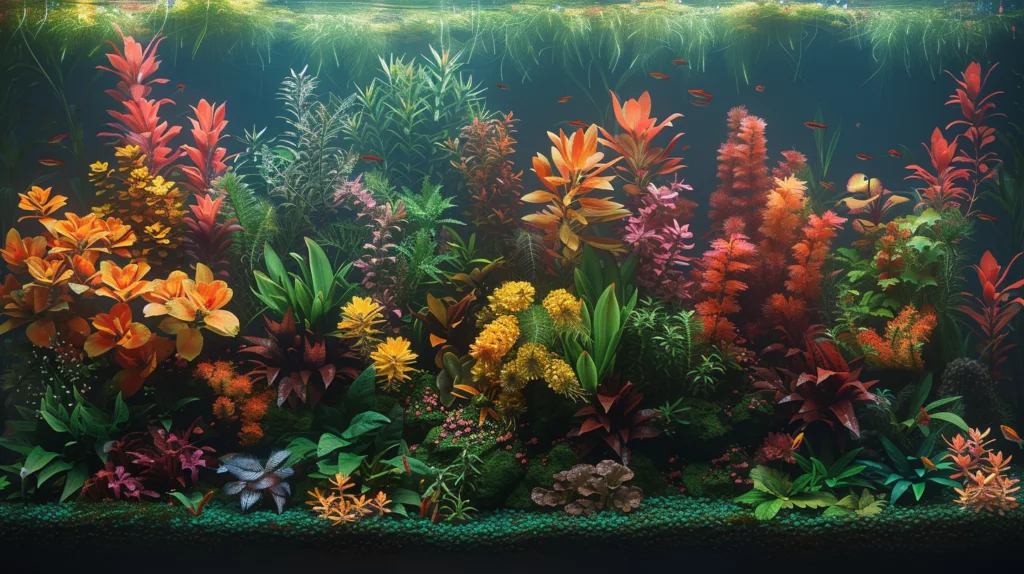
Freshwater aquarium plants are more than just decorations; they’re vital components of a thriving ecosystem. In maintaining water quality for all inhabitants, these aquatic plants strike a balance between oxygen production and waste absorption, while submerged in an aquarium.
Moreover, these plants that grow in a freshwater tank bring a part of the wild into our homes, transforming our aquariums into lush, underwater landscapes. They provide essential oxygen and shelter for our aquatic inhabitants, offering hiding spots and breeding grounds that mimic their natural habitats.
Incorporating freshwater aquarium plants into our setups essentially boils down to creating a beautiful ecosystem where live aquatic plants look their best. It’s about replicating nature’s intricate balance in our homes.
Deciphering the Layout: Foreground, Midground, and Background Aquarium Plants
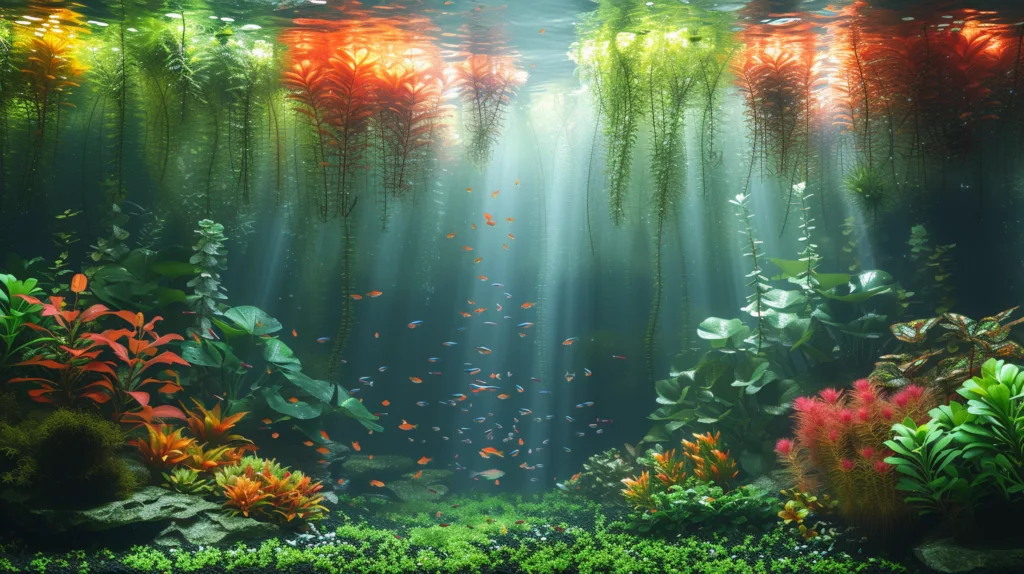
Creating an enchanting aquatic landscape requires understanding the distinct roles that foreground, midground, and background plants play in your aquarium’s design.
- Foreground Plants: These plants cover the substrate and offer a lush, carpet-like appearance. Ideal types are low-growing and thrive under a variety of lighting conditions.
- Midground Plants: These plants act as a bridge between the foreground and background, adding depth and interest. They should accentuate the foreground without obstructing the back.
- Background Plants: For the background, we aim for plants that offer visual depth and height. These plants should be robust and capable of growing towards the light, framing the entire setup beautifully.
By combining these layers thoughtfully, we create an aquarium that’s not just a collection of plants but a living piece of art.
Popular Aquarium Plants to Consider for Your Freshwater Setup
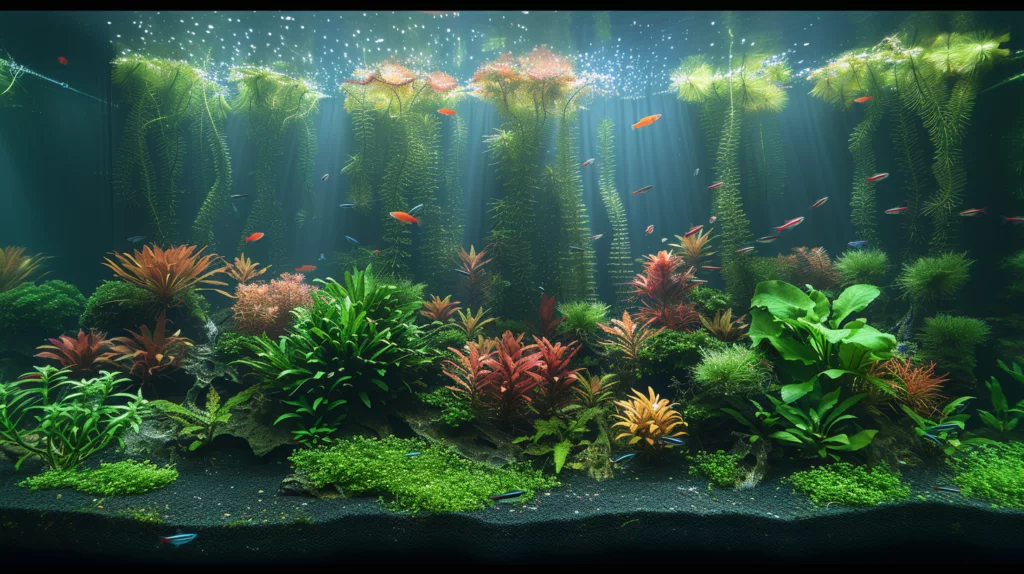
Diving into the world of freshwater aquariums, let’s explore popular plants that can elevate the beauty and health of your setup. When we’re choosing plants, we prioritize those that do not require extensive care, ensuring everyone has the freedom to create a thriving aquatic environment with ease. Here’s a sneak peek into some favorites:
| Plant Type | Features |
|---|---|
| Anubias | Easy to grow plants like vallisneria and anubias nana are some of the easiest picks, perfect for beginners looking to set up their home aquarium where plants thrive. |
| Java Fern | Low maintenance, ideal for the middle of the tank |
| Water Wisteria | Fast-growing like vallisneria, provides excellent cover, and is a fine choice of carpeting plant. |
| Duckweed | A floating plant that purifies water |
| Amazon Sword | Large, creates a stunning backdrop |
These plants cater to various aquarium plants need, from those looking for a lush background with the Amazon Sword to enthusiasts seeking plants for the middle to enhance the tank’s depth.
Anubias and Java Fern represent plants that do not require much light or specialized substrates, making them excellent choices for novices. Moreover, incorporating a floating plant like Duckweed adds to the diversity of your setup, helping to ensure a balanced ecosystem.
Dive Deep into the World of Aquarium Moss

Let’s explore the lush world of aquarium moss, a key element in creating vibrant, healthy freshwater habitats. Delving into this realm not only enhances the aesthetic appeal of our tanks but also serves pivotal roles in the underwater ecosystem.
Aquarium moss offers numerous benefits, from providing shelter for fish and invertebrates to improving water quality by absorbing excess nutrients. This is a cornerstone for those of us seeking a slice of underwater freedom in our living spaces, where plants thrive.
Here’s a quick guide to get you started:
- Understanding the Benefits: Aquarium moss acts as a natural filter, offers a breeding ground and hideout for fauna, and contributes to the overall balance of the aquarium ecosystem.
- Most Popular Types: The best choice for moss includes favorites such as Java Moss, Christmas Moss, Flame Moss, and Weeping Moss. Each type brings a unique texture and growth pattern to the aquarium, making it possible to achieve various aquascaping designs.
- Care Tips: Generally, aquarium moss, similar to anubias nana, requires minimal care. Moderate lighting and clean water are enough to keep the red tiger lotus, one of the easiest and most versatile plants, thriving. However, it appreciates a bit of CO2 and nutrients, which can boost its growth and vibrancy.
- Propagation Methods: Propagating aquarium moss is straightforward. Simply divide or cut a portion of the moss or stem plants like hornwort and attach it to a new surface in your home aquarium. This plant for the foreground will start to spread promptly, covering the area with its lush, green leaves carpet.
Understanding the care and how to grow and propagate aquarium moss empowers us to create thriving underwater worlds. With these popular types and tips in mind, we’re equipped to dive deeper into the fascinating journey of aquascaping, where freedom and creativity know no bounds.
Can Freshwater Aquarium Plants Coexist with Jellyfish in the Same Tank?
Freshwater aquarium plants can create your own jellyfish tank, but they may not coexist with jellyfish. Jellyfish need specific tank conditions and may outcompete plants for nutrients. However, some hardy plants like Java Fern or Anubias can survive in a jellyfish tank with proper care.
Cultivating and Caring for Your Freshwater Aquarium Plants
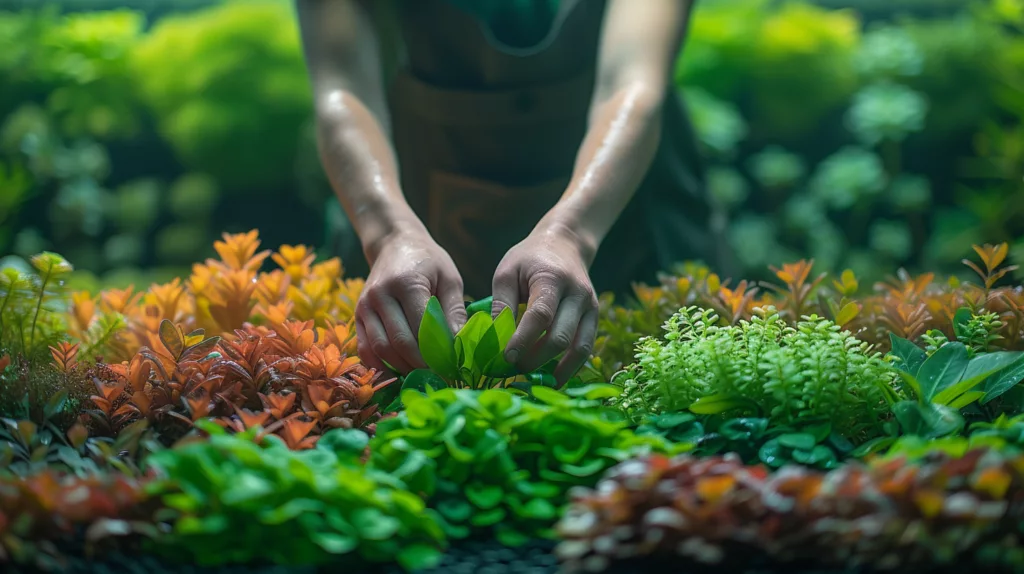
Cultivating a thriving freshwater aquarium requires a keen understanding of how to properly plant and care for aquatic plants. We’ve got the freedom to create a lush underwater landscape, but it comes with the responsibility to ensure our plants have everything they need to flourish.
- First off, choosing the right substrate is crucial for plant grows, whether in high light or low light conditions. It’s not just about aesthetics; the substrate is the foundation that anchors our plants and provides essential nutrients for plant grows.
- Light is another key player in our plant’s growth. They need the right amount and type of light to photosynthesize effectively, transforming light into the energy they need to grow.
- Nutrients play a pivotal role too. While some are available in the substrate, others might need to be added to the water. We’re talking about fertilizers here, but let’s not overdo it for many plants. Finding the right balance is essential to avoid algae overgrowth.
- CO2 is like the secret sauce for lush plant growth. Some live plants like anubias nana can get by with the CO2 naturally present in the water, but for a truly vibrant home aquarium, we might consider a CO2 injection system. It’s like supercharging our plants’ growth potential.
However, even with the best care, plants can encounter diseases. Recognizing the signs early and knowing how to treat them can save our underwater garden. Regular checks and maintaining a balanced environment in a home aquarium are our best defenses against diseases. Let’s stay vigilant, so our aquatic plants can thrive in a healthy, balanced ecosystem.
Conclusion
In wrapping up, we’ve journeyed through the fascinating world of freshwater aquarium plants, from understanding their vital role in our setups to exploring the varied types suited for different tank sections.
We’ve delved into the lush realm of aquarium moss and shared tips on nurturing these green beauties.
Armed with this guide, we’re ready to transform our aquariums into thriving underwater gardens, ensuring a healthier environment for our aquatic friends and a visually stunning display for us to enjoy.
Frequently Asked Questions
What are the best aquarium plants for beginners?
Some of the best aquarium plants for beginners include Java Fern, Anubias, Amazon Sword, and Java Moss. These plants, including bright green ones like anubias nana, are relatively easy to care for and can thrive in various water conditions of the home aquarium.
How do I grow aquarium plants in my fish tank?
To grow aquarium plants in your fish tank, you need to provide suitable lighting, maintain proper water conditions, and consider using fertilizers or supplements to support plant growth. Moreover, selecting the right plant species, an example being the bright green hornwort, one of the most popular plants for a freshwater tank setup, is crucial for successful growth.
What are some popular foreground aquarium plants?
Popular foreground aquarium plants include Dwarf Hairgrass, Dwarf Baby Tears, and Monte Carlo. These plants are known for their low-growing and carpeting properties, making them ideal for creating a lush foreground in your planted aquarium.
Can floating aquarium plants provide benefits to my tank?
Yes, floating aquarium plants such as Water Lettuce and Duckweed can offer several benefits to your tank. They help in nutrient absorption, provide shade for fish, and contribute to oxygenation of the water, creating a more balanced ecosystem.
What are some tips for maintaining live aquarium plants?
To maintain live aquarium plants, it’s essential to regularly trim overgrown plants, monitor water parameters, and address any issues related to plant diseases or algae. Additionally, considering that aquatic plants require sufficient light and contemplating the use of carbon dioxide supplementation can promote healthy plant growth.

